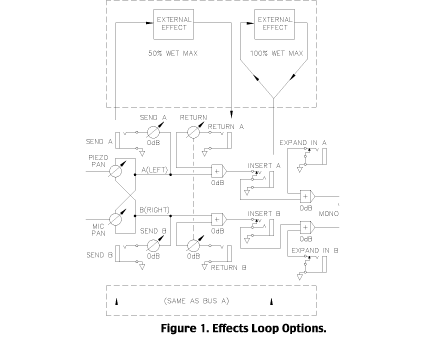OPTIMIZING PICKUP GAIN CONTROLS
The Gain of each pickup input is adjusted via recessed PICKUP GAIN TRIM controls on the front of the AP 13. Unity Gain is located at approximately 9:00. To set the Gain use a screw driver, guitar pick, or other suitable tool to turn the GAIN TRIM clockwise until a very strong input signal (e.g. strumming a loud chord) causes the overload LED to flicker occasionally. For extra headroom, turn the GAIN TRIM slightly counterclockwise.
SETTING UP EACH PICKUP
Start by turning one of the LEVEL controls to off or “0”. Now play your instrument and use the LOW CUT filter and EQ sliders to adjust for the desired timbre. (Try rolling off the low end of the MIC for presence, and roll off the high end of the PIEZO to reinforce the sound without shrillness.) Turn this Channel’s LEVEL control off and repeat the procedure for the other pickup. When through, adjust both LEVEL controls for optimum loudness balance and use the PAN sliders to create a panoramic sound field between the A and B Outputs. If the sound seems weak or thin when both pickups are turned up, especially a noticeable loss of bass, try using one or the other of the INVERT pushbuttons. This problem often occurs when pickups are out-of-phase and their outputs are canceling instead of combining.
SEND/RETURN vs. INSERT
An effect unit will deliver a full “wet” signal when patched into the INSERT. A standard TRS insert style (tip-send,ring-return) Y-cord gets input and output from the INSERT jack to the effects unit. In the SEND and RETURN loop, the most you can obtain is a 50% effects signal, because the dry signal is internally mixed with the return. See Figure 1 to the right. Another effects tip: If you want to put one effect on just the mic, and a different effect on just the piezo, but you want a mono output, just pan everything hard left and right for stereo and push the MONO switch on the rear of the AP 13.
EXPAND JACKS
Signal entering the AP 13 through these jacks sums (post-EQ and effects loops) with the internal signal. Mono signal applied to the A (MONO) EXPAND IN jack sums equally into Main A and B Outputs.

EFFECTS LOOPS
Most often the SEND/RETURN loop is used for a reverb, while something more specialized like a compressor or multi-effects processor fills the INSERT loop. Hook-up is simple: connect the SENDs to the inputs of the reverb and run the outputs back to the RETURN jacks. To send mono and return stereo, connect only the SEND A (MONO) jack to the input and return both outputs to the RETURN jacks; or to send and receive mono use just the A (MONO) SEND and RETURN jacks. The AP 13 splits and sums the mono input equally with the A and B Outputs. Adjust the SEND & RETURN sliders as necessary for correct levels. The INSERT loops are the single 1/4" send/return type where tip=send and ring=return. Use standard stereo (2-conductor) cable with a stereo jack on one end, then split it out into two mono (1-conductor) cables with mono jacks on the other. These are common enough, you shouldn’t have to make them. There are no controls to worry about with this loop.
CONNECTING TWO GUITARS TO THE AP 13
A Y-cord can be used, as long as you don’t try to run two piezo pickups. The impedance of a piezo won’t work right in the MIC channel, but it won’t hurt anything either. (Qualifier: If you have a piezo system that has active circuitry like a battery powered preamp, then run it into the MIC channel with the straight piezo in the PIEZO channel.)

MAIN OUTPUTS
Two sets of Main Outputs exist. Both are fully balanced, both may be used at the same time. The 1/4" TRS jack operates at line-level and should be used to drive additional signal processing, your power amplifier, or any line-level inputs. The XLR connectors are intended for mic-level inputs on mixers, tape recorders or a snake. This level is 40 dB less than the line-level outputs. It is, in effect, a built-in direct box.


